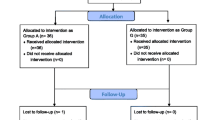Abstract
The objective of this study was to study the short-term impact on larynx by a newly designed anatomical tube. A prospective randomised trial of a newly designed anatomical tube versus a standard endotracheal tube in patients operated under general anaesthesia for at least 12 h. Seventy adults were included and randomised to either type of tube. The patients were evaluated by means of fibre-optic laryngoscopy and VAS-rating of symptoms on two occasions in the first post-operative week. The evaluating investigators and the patients were blinded to the type of tube used. 27 cases and 23 controls had complete data for evaluation. Age, gender and intubation times were comparable. Symptoms such as hoarseness, coughing, and pain were rated above 30 % of maximum during at least one of the first post-operative days by 21 and 19 patients, respectively. At the first examination (within 24 h), 38 % of patients in the anatomical tube group stated no hoarseness; compared to 13 % of the controls (p = 0.057). Fibre-optic laryngoscopy showed some kind of pathology in all the patients examined within 24 h of extubation. After 3–6 days, seven patients with the anatomical tube and four patients in the control group showed complete resolution of the lesions, and the changes were limited to redness in the vocal process area in another seven and four, respectively. The differences between the groups did not attain statistical significance. The study shows considerable short-term laryngeal morbidity after prolonged intubation, and the anatomical tube only showed an advantage concerning hoarseness. Further improvement of the endotracheal tubes and intubation routines are still needed.


Similar content being viewed by others
References
Benjamin B (1993) Prolonged intubation injuries of the larynx: endoscopic diagnosis, classification, and treatment. Ann Otol Rhinol Laryngol (suppl 102):1–15
Lacau Saint Guily J, Boisson-Bertrand D, Monnier P (2003) Lesions to lips, oral and nasal cavities, pharynx, larynx, trachea and esophagus due to endotracheal intubation and its alternatives. Ann Fr Anesth Reanim 22(Suppl 1):81s–96s
Higgins PP, Chung F, Mezei G (2002) Postoperative sore throat after ambulatory surgery. Br J Anaesth 88:582–584
Wu CL, Berenholtz SM, Pronovost PJ, Fleisher LA (2002) Systematic review and analysis of postdischarge symptoms after outpatient surgery. Anesthesiology 96:994–1003
McHardy FE, Chung F (1999) Postoperative sore throat: cause, prevention and treatment. Anaesthesia 54(5):444–453
Domino KB, Posner KL, Caplan RA, Cheney FW (1999) Airway injury during anesthesia: a closed claims analysis. Anesthesiology 91(6):1703–1711
Alexopoulos C, Larsson SG, Lindholm CE (1983) Anatomical shape of the airway. Acta Anaesthesiol Scand 27(3):185–192
Alexopoulos C, Larsson SG, Lindholm CE (1983) The anatomy of the airway during endotracheal intubation. Acta Anaesthesiol Scand 27(4):331–334
Eckerbom B, Lindholm CE, Alexopoulos C (1986) Airway lesions caused by prolonged intubation with standard and with anatomically shaped tracheal tubes. A post-mortem study. Acta Anaesthesiol Scand 30(5):366–373
Alexopoulos C, Larsson SG, Lindholm CE (1983) The conformity of an anatomically shaped endotracheal tube to the shape of the airway. Acta Anaesthesiol Scand 27(4):335–338
Alexopoulos C, Lindholm CE (1983) Airway complaints and laryngeal pathology after intubation with an anatomically shaped endotracheal tube. Acta Anaesthesiol Scand 27(4):339–344
Lindholm CE, Randestad A, Gertzén H (2003) New design of a tracheostomy-cricothyroidostomy tube. Eur Arch Otorhinolaryngol 260(8):421–424 Epub 2003 Apr 23
Mencke T, Echternach M, Kleinschmidt S, Lux P, Bart V, Plinkert PK et al (2003) Laryngeal morbidity and quality of tracheal intubation: a randomized controlled trial. Anesthesiology 98:1049–1056
Author information
Authors and Affiliations
Corresponding author
Ethics declarations
Conflict of interest
Carl-Eric Lindholm has financial interests in Medical Products Octagon Uppsala, Sweden (the manufacturer of the LAO tube). He participated in the design of the study, but not in the evaluation of the patients or the data analysis. The other authors have no conflicts of interest.
Ethical standard
The study was approved by the Ethics Committee of the Akademiska University hospital (Reference Number 02-153).
Rights and permissions
About this article
Cite this article
Nordang, L., Lindholm, CE., Larsson, J. et al. Early laryngeal outcome of prolonged intubation using an anatomical tube: a double blind, randomised study. Eur Arch Otorhinolaryngol 273, 703–708 (2016). https://doi.org/10.1007/s00405-015-3803-6
Received:
Accepted:
Published:
Issue Date:
DOI: https://doi.org/10.1007/s00405-015-3803-6




